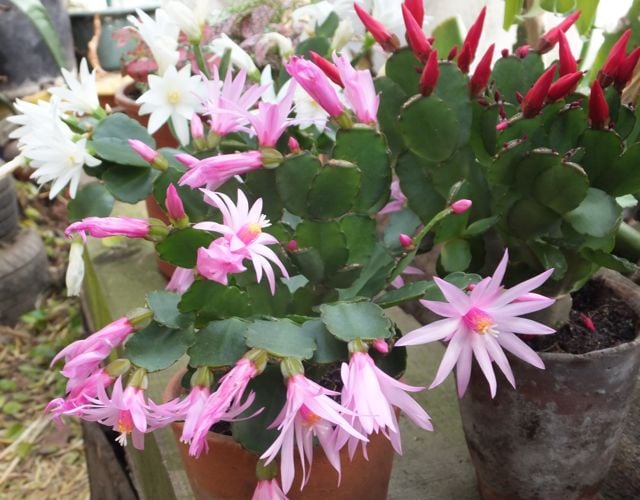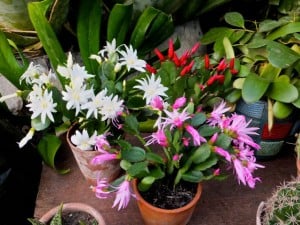
Houseplants much at home in a warm greenhouse are the Christmas and Easter cactus, and for Americans, Thanksgiving cactus as well. Tough and long enduring these have been rightly popular since Victorian times.
 The Latin names have changed so often it’s now more sensible to revert to the common names most people are familiar with. The Christmas cactus was long known as Zygocactus, then put in with Easter cacti Schlumbergera, then all moved to Rhipsalidopsis and now Hatiora. There has also been hybridizing with other close relations improving the flower timing and colours. Thus Latin names are a tad confusing when all you want is a plant to bloom at the appropriate time.
The Latin names have changed so often it’s now more sensible to revert to the common names most people are familiar with. The Christmas cactus was long known as Zygocactus, then put in with Easter cacti Schlumbergera, then all moved to Rhipsalidopsis and now Hatiora. There has also been hybridizing with other close relations improving the flower timing and colours. Thus Latin names are a tad confusing when all you want is a plant to bloom at the appropriate time.
Once known as Epiphyllums or Orchid cacti these originate from tree dwelling ancestors in the central American rain forests. A lot easier to keep going than orchids many families have an heirloom plant passed down through the generations. Old plants may reach a yard or more across and hang down by the same (though often reduced as pieces get taken off for other family members).
The plants are technically stems, with deeply scalloped edges, though to all but botanists these are thick leaves. From the edges of these thick leaves emerge the gorgeous most brilliantly coloured flowers in crimson with variations through red to purple and white.
 The Easter blooming sorts have tufts of inoffensive spines, more bristles, on their distinctive, linked flat oval stem-leaves. The Christmas forms are smooth with rounded edges. Both initially stand up when the plants are young but arch over with size to hang down, making these good subjects for hanging containers.
The Easter blooming sorts have tufts of inoffensive spines, more bristles, on their distinctive, linked flat oval stem-leaves. The Christmas forms are smooth with rounded edges. Both initially stand up when the plants are young but arch over with size to hang down, making these good subjects for hanging containers.
The many varieties, and their very numerous and most collectable relations, require similar conditions. Dappled shade not full sun except in the very darkest months, with cool, never cold, never hot, temperatures. They need well-drained leaf mould compost with careful watering, almost drying out before re-wetting especially in the cooler months. Warmed rainwater of course, with a little liquid feeding in the growing season. Syringing in the hotter drier summer months keeps the plants happy and the red spider mite away. If you want more plants each and very bit will root, even better given bottom heat. (Some Christmas cacti are grafted on a short trunk of another stiffer cactus and parts from that will not come true.)
The flowering is determined by a period of short days with long completely dark nights. Where there is a street or security light the plants may not come into bloom reliably otherwise they are quite dependable.
Christmas cacti bloom about Christmastime most years. The Thanksgiving sorts come that little earlier but obviously are not much seen in the UK. The Easter cacti have a much harder task as Easter moves each year by a month or more, these come into flower sometime between late winter and early summer so to be fair a direct hit is rare.










